Abstract
1. This study investigated tachykinin-evoked vasodilatation in the microvasculature of the hamster cheek pouch in vivo. Arterioles and venules were observed by intravital microscopy with video recording, and vasodilatation and constriction, defined as changes in blood vessel diameter, measured by image analysis. All agents were applied topically by superfusion. None of the agents tested had a significant effect on venule diameter. 2. When arterioles were preconstricted (by ca. 50%) with endothelin-1 present in the superfusing medium, substance P (0.3-30 nM) was a potent vasodilator, being 10 fold more active than both neurokinin A and the NK1 receptor-selective agonist, substance P methyl ester. The NK2 receptor-selective agonist, [beta-Ala8]-NKA(4-10)(0.1-10 microM) was active only at high concentrations, and the NK3 receptor-selective agonist senktide (0.1-10 microM) was virtually inactive (n = 8 hamsters). Dilatation evoked by tachykinins and analogues was rapid in onset (< 0.5 min) and readily reversible. 3. At low concentrations (1-10 nM), the non-peptide tachykinin NK1 receptor antagonist SR140333 ((S)1-(2-[3(3,4-dichlorophenyl)-1-(3-iso-propoxyphenylacetyl)pi peridin-3- yl]ethyl)-4-phenyl-1-azoniabicyclo[2.2.2]octone, chloride) had no effect on the diameter of preconstricted arterioles per se, but potently inhibited dilator responses to substance P methyl ester (apparent pKB 9.9 +/- 0.2; n = 5 hamsters, n = 10 estimates). SR140333 (10 nM) did not inhibit submaximal dilator responses evoked by human alpha calcitonin gene-related peptide (alpha CGRPh; 1.0 nM; P > 0.05; n = 5).(ABSTRACT TRUNCATED AT 250 WORDS)
Full text
PDF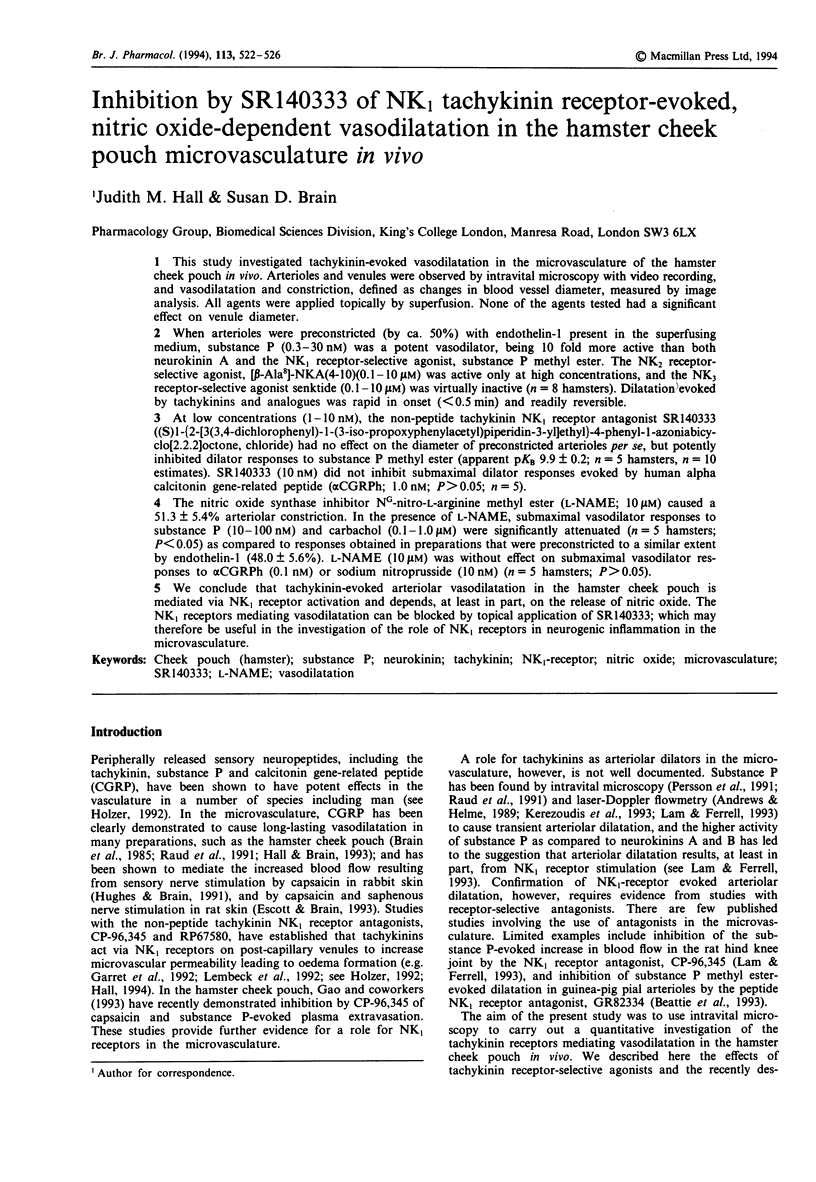
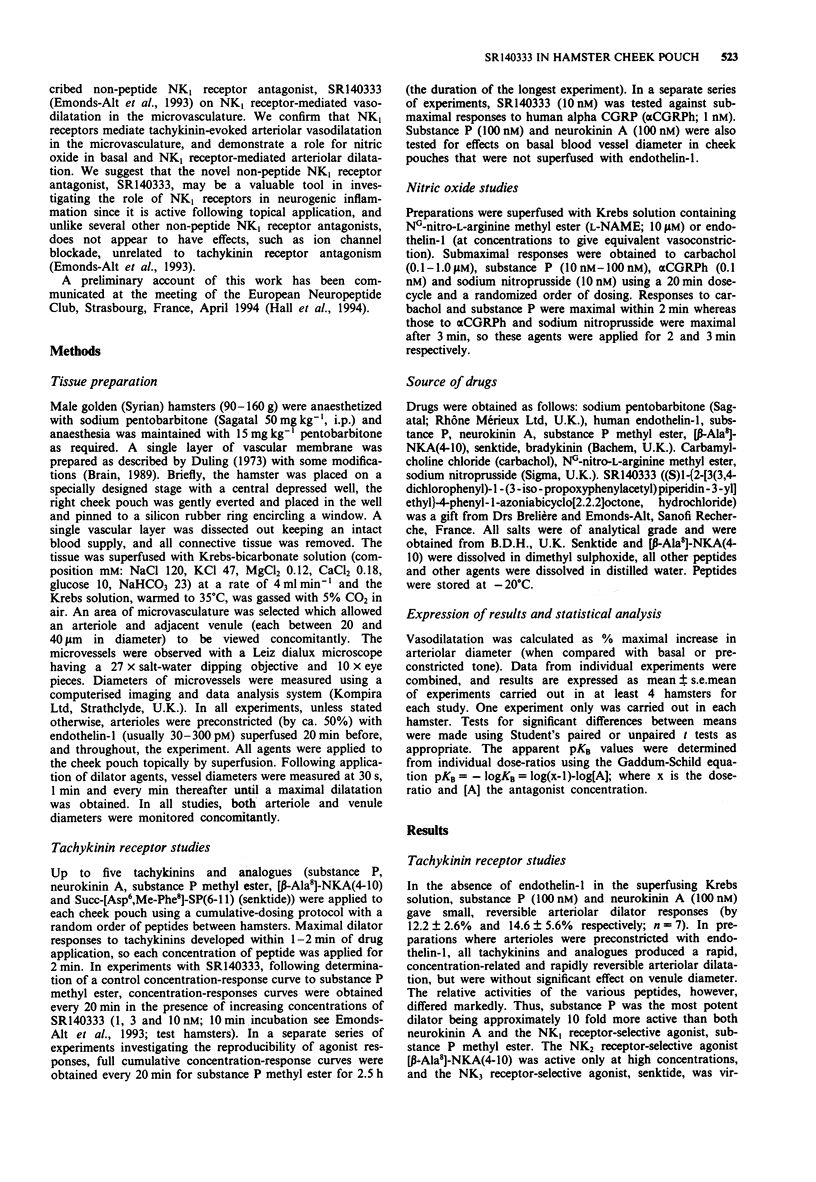
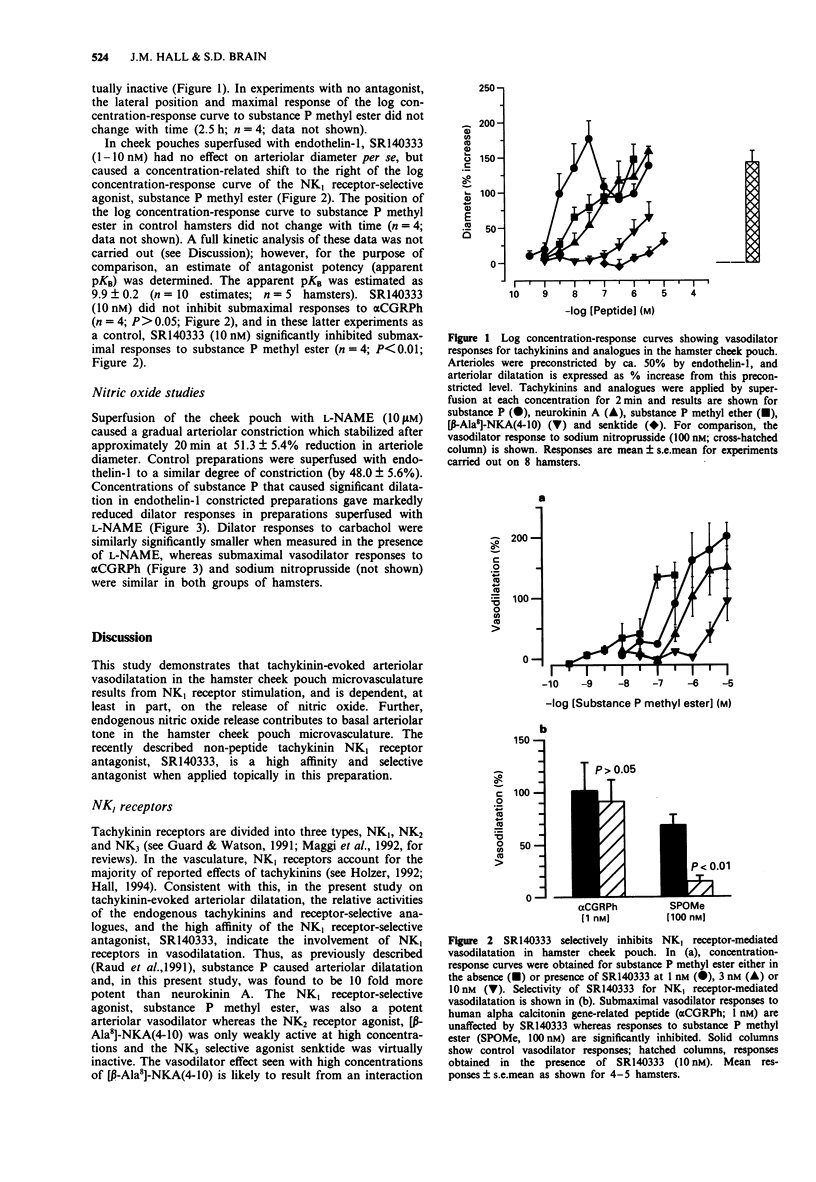
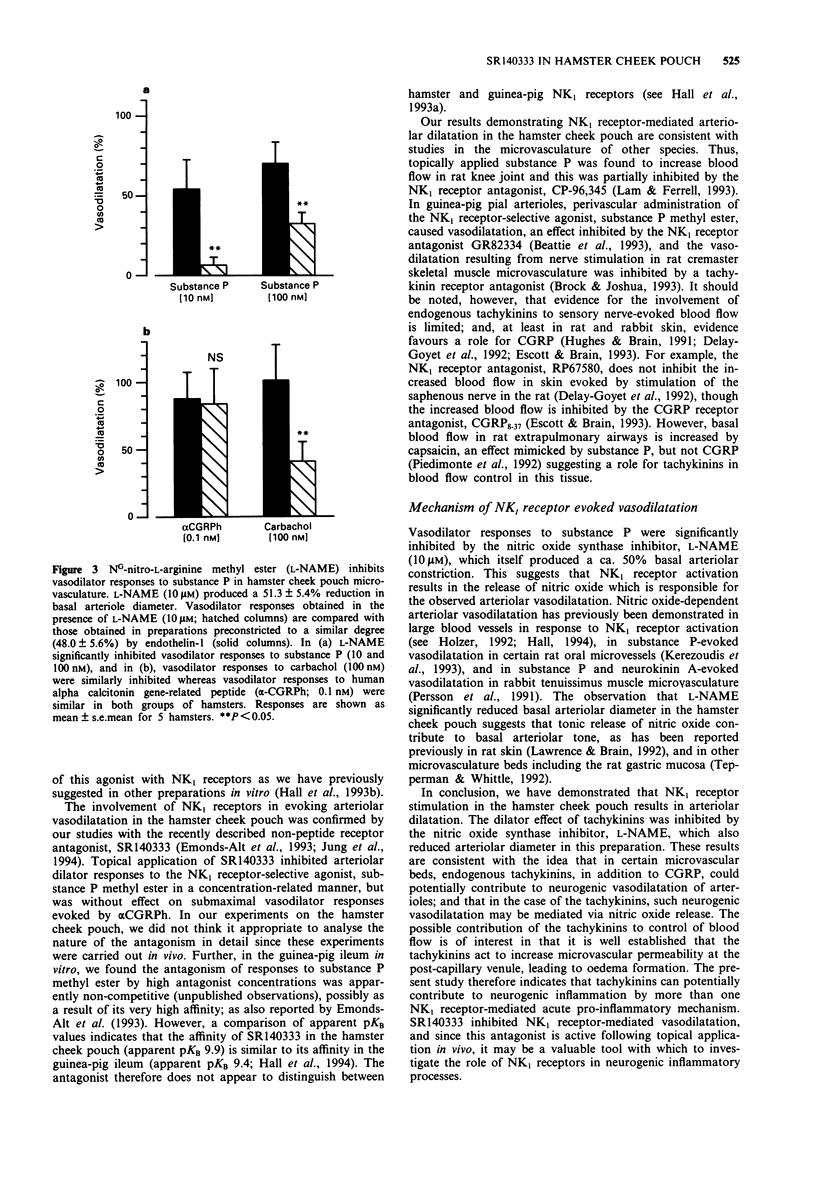
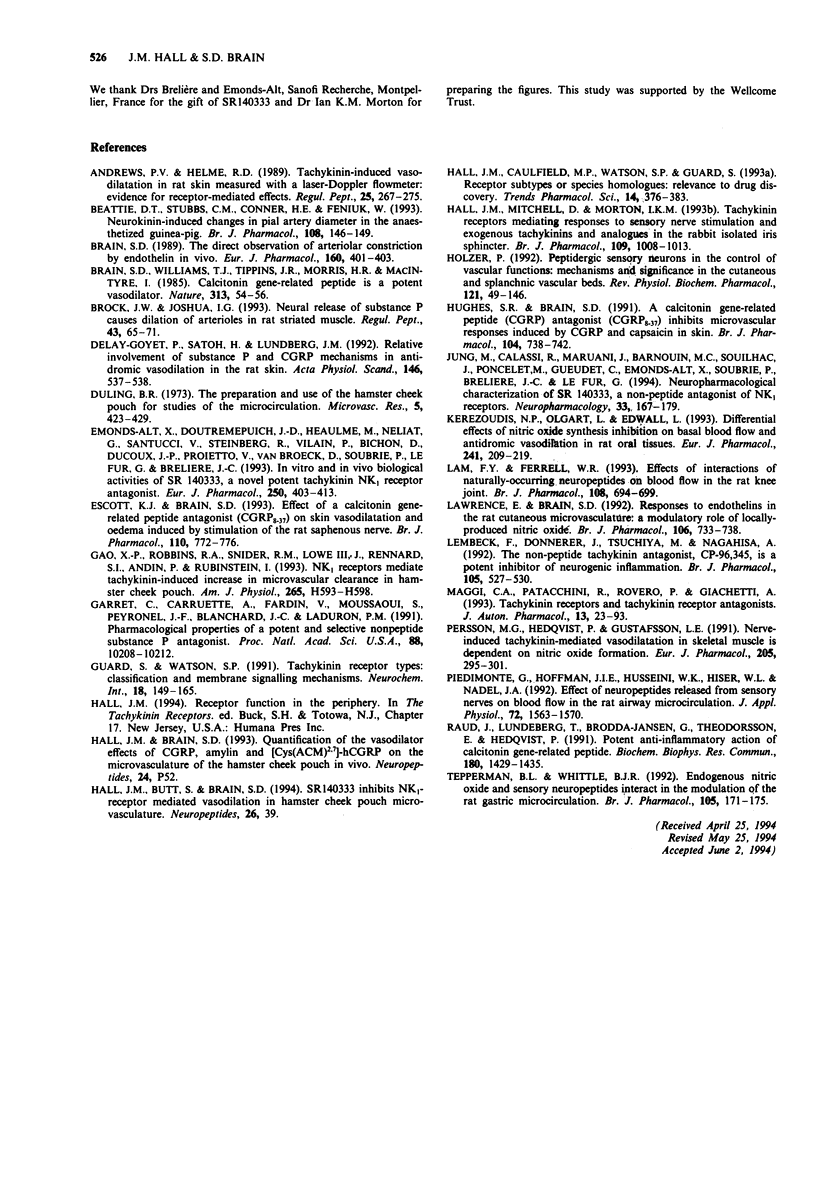
Selected References
These references are in PubMed. This may not be the complete list of references from this article.
- Andrews P. V., Helme R. D. Tachykinin-induced vasodilatation in rat skin measured with a laser-Doppler flowmeter: evidence for receptor-mediated effects. Regul Pept. 1989 Jun-Jul;25(3):267–275. doi: 10.1016/0167-0115(89)90175-4. [DOI] [PubMed] [Google Scholar]
- Beattie D. T., Stubbs C. M., Connor H. E., Feniuk W. Neurokinin-induced changes in pial artery diameter in the anaesthetized guinea-pig. Br J Pharmacol. 1993 Jan;108(1):146–149. doi: 10.1111/j.1476-5381.1993.tb13454.x. [DOI] [PMC free article] [PubMed] [Google Scholar]
- Brain S. D. The direct observation of arteriolar constriction induced by endothelin in vivo. Eur J Pharmacol. 1989 Feb 7;160(3):401–403. doi: 10.1016/0014-2999(89)90096-4. [DOI] [PubMed] [Google Scholar]
- Brain S. D., Williams T. J., Tippins J. R., Morris H. R., MacIntyre I. Calcitonin gene-related peptide is a potent vasodilator. Nature. 1985 Jan 3;313(5997):54–56. doi: 10.1038/313054a0. [DOI] [PubMed] [Google Scholar]
- Brock J. W., Joshua I. G. Neural release of substance P causes dilation of arterioles in rat striated muscle. Regul Pept. 1993 Jan 22;43(1-2):65–71. doi: 10.1016/0167-0115(93)90408-z. [DOI] [PubMed] [Google Scholar]
- Delay-Goyet P., Satoh H., Lundberg J. M. Relative involvement of substance P and CGRP mechanisms in antidromic vasodilation in the rat skin. Acta Physiol Scand. 1992 Dec;146(4):537–538. doi: 10.1111/j.1748-1716.1992.tb09460.x. [DOI] [PubMed] [Google Scholar]
- Duling B. R. The preparation and use of the hamster cheek pouch for studies of the microcirculation. Microvasc Res. 1973 May;5(3):423–429. doi: 10.1016/0026-2862(73)90059-9. [DOI] [PubMed] [Google Scholar]
- Emonds-Alt X., Doutremepuich J. D., Heaulme M., Neliat G., Santucci V., Steinberg R., Vilain P., Bichon D., Ducoux J. P., Proietto V. In vitro and in vivo biological activities of SR140333, a novel potent non-peptide tachykinin NK1 receptor antagonist. Eur J Pharmacol. 1993 Dec 21;250(3):403–413. doi: 10.1016/0014-2999(93)90027-f. [DOI] [PubMed] [Google Scholar]
- Escott K. J., Brain S. D. Effect of a calcitonin gene-related peptide antagonist (CGRP8-37) on skin vasodilatation and oedema induced by stimulation of the rat saphenous nerve. Br J Pharmacol. 1993 Oct;110(2):772–776. doi: 10.1111/j.1476-5381.1993.tb13878.x. [DOI] [PMC free article] [PubMed] [Google Scholar]
- Gao X. P., Robbins R. A., Snider R. M., Lowe J., 3rd, Rennard S. I., Anding P., Rubinstein I. NK1 receptors mediate tachykinin-induced increase in microvascular clearance in hamster cheek pouch. Am J Physiol. 1993 Aug;265(2 Pt 2):H593–H598. doi: 10.1152/ajpheart.1993.265.2.H593. [DOI] [PubMed] [Google Scholar]
- Garret C., Carruette A., Fardin V., Moussaoui S., Peyronel J. F., Blanchard J. C., Laduron P. M. Pharmacological properties of a potent and selective nonpeptide substance P antagonist. Proc Natl Acad Sci U S A. 1991 Nov 15;88(22):10208–10212. doi: 10.1073/pnas.88.22.10208. [DOI] [PMC free article] [PubMed] [Google Scholar]
- Hall J. M., Caulfield M. P., Watson S. P., Guard S. Receptor subtypes or species homologues: relevance to drug discovery. Trends Pharmacol Sci. 1993 Oct;14(10):376–383. doi: 10.1016/0165-6147(93)90096-3. [DOI] [PubMed] [Google Scholar]
- Hall J. M., Mitchell D., Morton I. K. Tachykinin receptors mediating responses to sensory nerve stimulation and exogenous tachykinins and analogues in the rabbit isolated iris sphincter. Br J Pharmacol. 1993 Aug;109(4):1008–1013. doi: 10.1111/j.1476-5381.1993.tb13721.x. [DOI] [PMC free article] [PubMed] [Google Scholar]
- Holzer P. Peptidergic sensory neurons in the control of vascular functions: mechanisms and significance in the cutaneous and splanchnic vascular beds. Rev Physiol Biochem Pharmacol. 1992;121:49–146. doi: 10.1007/BFb0033194. [DOI] [PubMed] [Google Scholar]
- Hughes S. R., Brain S. D. A calcitonin gene-related peptide (CGRP) antagonist (CGRP8-37) inhibits microvascular responses induced by CGRP and capsaicin in skin. Br J Pharmacol. 1991 Nov;104(3):738–742. doi: 10.1111/j.1476-5381.1991.tb12497.x. [DOI] [PMC free article] [PubMed] [Google Scholar]
- Jung M., Calassi R., Maruani J., Barnouin M. C., Souilhac J., Poncelet M., Gueudet C., Emonds-Alt X., Soubrié P., Brelière J. C. Neuropharmacological characterization of SR 140333, a non peptide antagonist of NK1 receptors. Neuropharmacology. 1994 Feb;33(2):167–179. doi: 10.1016/0028-3908(94)90004-3. [DOI] [PubMed] [Google Scholar]
- Kerezoudis N. P., Olgart L., Edwall L. Differential effects of nitric oxide synthesis inhibition on basal blood flow and antidromic vasodilation in rat oral tissues. Eur J Pharmacol. 1993 Sep 14;241(2-3):209–219. doi: 10.1016/0014-2999(93)90205-v. [DOI] [PubMed] [Google Scholar]
- Lam F. Y., Ferrell W. R. Effects of interactions of naturally-occurring neuropeptides on blood flow in the rat knee joint. Br J Pharmacol. 1993 Mar;108(3):694–699. doi: 10.1111/j.1476-5381.1993.tb12863.x. [DOI] [PMC free article] [PubMed] [Google Scholar]
- Lawrence E., Brain S. D. Responses to endothelins in the rat cutaneous microvasculature: a modulatory role of locally-produced nitric oxide. Br J Pharmacol. 1992 Jul;106(3):733–738. doi: 10.1111/j.1476-5381.1992.tb14402.x. [DOI] [PMC free article] [PubMed] [Google Scholar]
- Lembeck F., Donnerer J., Tsuchiya M., Nagahisa A. The non-peptide tachykinin antagonist, CP-96,345, is a potent inhibitor of neurogenic inflammation. Br J Pharmacol. 1992 Mar;105(3):527–530. doi: 10.1111/j.1476-5381.1992.tb09013.x. [DOI] [PMC free article] [PubMed] [Google Scholar]
- Maggi C. A., Patacchini R., Rovero P., Giachetti A. Tachykinin receptors and tachykinin receptor antagonists. J Auton Pharmacol. 1993 Feb;13(1):23–93. doi: 10.1111/j.1474-8673.1993.tb00396.x. [DOI] [PubMed] [Google Scholar]
- Persson M. G., Hedqvist P., Gustafsson L. E. Nerve-induced tachykinin-mediated vasodilation in skeletal muscle is dependent on nitric oxide formation. Eur J Pharmacol. 1991 Dec 3;205(3):295–301. doi: 10.1016/0014-2999(91)90913-b. [DOI] [PubMed] [Google Scholar]
- Piedimonte G., Hoffman J. I., Husseini W. K., Hiser W. L., Nadel J. A. Effect of neuropeptides released from sensory nerves on blood flow in the rat airway microcirculation. J Appl Physiol (1985) 1992 Apr;72(4):1563–1570. doi: 10.1152/jappl.1992.72.4.1563. [DOI] [PubMed] [Google Scholar]
- Raud J., Lundeberg T., Brodda-Jansen G., Theodorsson E., Hedqvist P. Potent anti-inflammatory action of calcitonin gene-related peptide. Biochem Biophys Res Commun. 1991 Nov 14;180(3):1429–1435. doi: 10.1016/s0006-291x(05)81356-7. [DOI] [PubMed] [Google Scholar]
- Tepperman B. L., Whittle B. J. Endogenous nitric oxide and sensory neuropeptides interact in the modulation of the rat gastric microcirculation. Br J Pharmacol. 1992 Jan;105(1):171–175. doi: 10.1111/j.1476-5381.1992.tb14230.x. [DOI] [PMC free article] [PubMed] [Google Scholar]
- Vasar E., Lang A., Harro J., Kõks S., Volke V., Sihver S., Bourin M., Bradwejn J., Männistö P. T. Subdiaphragmatic vagotomy does not prevent the anti-exploratory effect of caerulein in the elevated plus-maze. Neuropeptides. 1994 Jan;26(1):39–45. doi: 10.1016/0143-4179(94)90091-4. [DOI] [PubMed] [Google Scholar]


